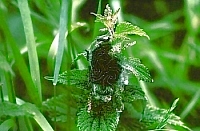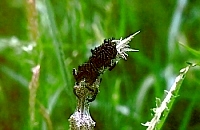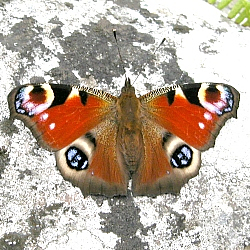The Peacock Butterfly
Habitat:
The Peacock butterfly like the Small Tortoiseshell is very well known for what look like eyes on the back of its wings. It can be found in most habitats. It may be frequently seen on nectar plants such as thistles at any time of the year except for a period in June/July.
Flight Time:
It becomes active on the first warm sunny day of spring sometimes as early as late March and flying until early May or later.
Hibernation:
Overwinters as an adult butterfly.
Ovum:
Ovipositing begins in May when olive-green oblong eggs are deposited in large clusters of 300-400 eggs and in layers, under the young leaves of Common Nettle Urtica dioica.
Larva:
The larvae hatch within 7-21 days and like the Small Tortoiseshell they spin a tent on the top of the plant by drawing a few leaves together with silk where they live and feed together. When these leaves are consumed they move on to fresh leaves to build another retreat. The mature larvae are velvety black with finely speckled white dots and many black spines. After about one month, when fully grown, they disperse to pupate.


^ ^ ^ ^ ^ ^ ^ ^ ^ Before And After Eating ^ ^ ^ ^ ^ ^ ^ ^ ^
Pupa:
The pupa is suspended, vertically downwards, by the center of the plant from a silken pad spun on the vegetation up to a metre from the ground. The pupal stage is around 2-4 weeks.

Adult:
Adults emerge from mid-July onwards. They seek out the nectar of flowering plants, especially Buddleia and Thistle in order to build up body reserves for hibernating. They usually enter hibernation by mid-September.
